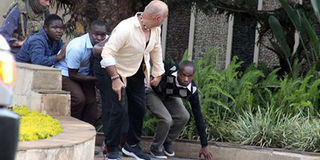Premium
Lessons and memories of Nairobi’s DusitD2 terror attack, four years later

Security officers respond to the Dusit attack on January 15, 2019.
It was a lazy afternoon. Tuesday, January 15, 2019, at 2.30 pm.
We had just strolled in from lunch when a colleague rushed to my desk.
"There is a terror attack at DusitD2, Riverside!" He broke the news and casually stood there like a statue. We looked at each other. We had now become accustomed to grenades and other al-Shabaab attacks.
However, Kenyan journalists are not trained to cover terror attacks or deal with extremists. Instead, they cover riots and election violence — stone-throwing, teargas and batons.
We scrambled a team very fast to avoid being scooped – as we say in the newsroom parlance. The instructions were, as usual, clear: "There is no story worth dying for. Keep safe!"
The two scribes and a photographer disappeared to the elevators.
As they left, we tried to reach our security contacts to understand the gravity of the attack. The September 21, 2013, Westgate attack, where four masked gunmen stormed into the shopping mall and left 68 dead, and the April 2, 2015, Garissa University College attack, which left 148 students dead, was still fresh in our minds.
These attacks had taught us to report from the fringes of fire; not too close and not too far. The Westgate siege lasted four days, and we had no idea how long this would last.

Images of the assailants were displayed in a 7-minute clip.
After the Westgate and Garissa University attacks, security agencies had learned how to handle terror sieges following the dramatic disorganisation that saw the Kenya Defence Forces' Rangers Strike Force exchange fire with the General Service Unit’s Recce Squad – and the delayed rescue in Garissa.
At the back of my mind, and perhaps those of other editors was this fear and hope that nobody would get in harm's way. Sometimes, in the line of duty, we forget that you have sent somebody's son, father, or husband to do a risky task. Suppose something untoward happens? You, pray.
Bulletproof jacket
After 30 minutes I hopped into a vehicle, headed to DusitD2, where I spent my afternoon. I would return on Wednesday, January 16, wearing a bulletproof jacket. When the militants arrived, an estimated 700 people were in the complex. Rescuing them was an arduous task.
The previous week, the international press had been awash with stories on the terror attack at the offices of the French satirical magazine Charlie Hebdo, where terrorists had gone looking for the editor, Stephane Charbonnier, four cartoonists, and three other editorial staff. They forced their way into the newsroom and called them by their names. Then they killed them — claiming the magazine had depicted Prophet Mohamed negatively.
I recall this because today is the fourth anniversary of DusitD2 attack – and many people tend to quickly forget as they rubbish the selfless actions of brave men and women in our security forces who risk their lives to keep us safe – or the unarmed journalist who goes to the frontline with only a microphone, a notebook and a pen, to bring you the story. Again, and sadly so, we are a nation of selective amnesia.
On the ground, near the driveway where smouldering wreckages of vehicles that had been torched by the terrorists as they stormed the complex stood, was George Kinoti, the then Director of Criminal Investigations, leading rescue efforts and coordinating his team. He had arrived before the Recce Unit squad got there from their Ruiru base with a small group.
On opening the vehicle that had been abandoned at the drop-arm barrier, they were unanimous that the attack pointed to terrorists. The attackers had left a grenade. For three days, Mr Kinoti — now Kenya Kwanza's punching bag and bogeyman — never left that complex. He and his team had set up a base to silence the terrorists. That may easily be forgotten.

Riverside complex in Nairobi.
Inside the vehicle was a phone and literature pointing to terrorism. A few metres away, a grenade had exploded, deflating the tyre of a parked vehicle.
After the Westgate and Garissa University attacks, the security apparatus knew they needed a professionally trained unit to handle sieges.
A team had been trained under the US Department of State's Antiterrorism Assistance program, and it was this group that was to offer a different approach.
After Westgate, a response unit was set up that would be based within the city to evade the Thika Superhighway traffic, which previously slowed down teams. This time, the GSU air cavalry unit had brought in some of the Recce Squad members.
14 Riverside Drive complex
The 14 Riverside Drive complex housed international organisations, banks and consultancies. There was a restaurant, Secret Garden, with a well-trimmed garden facing the Nairobi River. It was at this garden that the suicide bomber hit first. The CCTV footage showed the suicide bomber detonating his explosive vest at precisely 3.05 pm, after standing for a minute on the footpath next to the Secret Garden Restaurant.
Meanwhile, as we later learned, the terrorists, who had arrived in two cars, tossed grenades at the guards manning the drop bar and forced their way in. CCTV footage showed two armed with machine guns walking, and soon, they were four.
It was yet another siege as terror groups continued to test security systems.
Breaking up such clandestine terror cells and systems, solid and fluid, active and dormant, is the nightmare of any security intelligence. It is not easy to deal with shadowy miscreants who live as masquerades until they are mobilised to attack. That is the takeaway that Kenya's intelligence agencies learned ever since the August 1998 Nairobi US Embassy bombing, when they found out that the masterminds had set up decoy companies, bought fishing boats, and even set up a non-governmental organisation to supply mosquito nets.
For 19 hours, the lobby of Nairobi's DusitD2 complex was turned into "an active command and control centre”.
Unlike Westgate, there was no time for ego wars. All the teams were collapsed into a multiagency unit, and they brought in a senior property manager who informed the group about the layout of the complex. A police command centre was also established outside, headed by Deputy Inspector-General of Police Edward Mbugua, a former presidential escort commander.
The arrival of the Recce Squad around 4 pm changed the matrix as they entered the complex where the terrorists were holed up, with GSU Commandant Douglas Kanja coordinating the efforts with an operation intelligence team from the NIS Counter Terrorism unit.
With the help of electronic surveillance, the Recce Squad had picked out the terrorists, and by midnight, they had pushed them to the seventh floor and separated the hostages from them.
As they later said, the idea was first to get the hostages out and stage the last fight on the seventh floor.
With the reinforced steel-and-glass doors and with most of the hostages barricaded behind the doors, the terrorists could not reach them. Kenyans rallied together.
When the New York Times published images of the dead, Kenyans took on the incoming East Africa bureau chief, Kimiko de Freytas-Tamura, and demanded an apology.
They said it was racist since the paper could not do the same for Americans. They accused the paper of applying different standards for its photo usage.
"Absolutely distasteful, disgusting and deplorable. An utter disgrace," said Fadhili Kanini on Twitter.
By 10 am on Wednesday, when the siege was declared over, the senior security officials who came to the entrance to address the media looked tired and somnolent.
Emotions were running high even within government circles after it was found out that some of the attackers had passed through the Daadab refugee camp – which had become a soft landing.
Following the Garissa University attack, then-PresidentPresident Uhuru Kenyatta had in March 2017 ordered the closure of the Dadaab camp but was heavily criticised by human rights organisations.

Workers are guided to safety by security agents during the rescue operation at DusitD2 Hotel in Nairobi on January 15, 2019.
Amnesty International said, "By offering no options other than return to Somalia, the (Jubilee) government (was) effectively forcing refugees to leave Kenya."
But the High Court stopped the government's bid to close the camps. Justice John Mativo ruled that then Interior Cabinet Secretary, the late Joseph Nkaissery and Principal Secretary Karanja Kibicho, had acted beyond their powers in issuing the directive to close the refugee camp.
In the US, President Donald Trump announced the "decapitation" policy to target key al-Shabaab leaders.
On the fourth anniversary of the DusitD2 attack, there have been various foiled attacks, according to intelligence sources. That no significant attack has happened means that somebody has acted on intelligence – or that a proper framework is in place. Terrorists love a vacuum. They thrive in chaos.
May all those who lost their lives rest in peace. May those who still face the trauma of DusitD2 get healing. And may all the security agents who risked their lives, or got injured, know that we care – some of us.
[email protected] @johnkamau1





